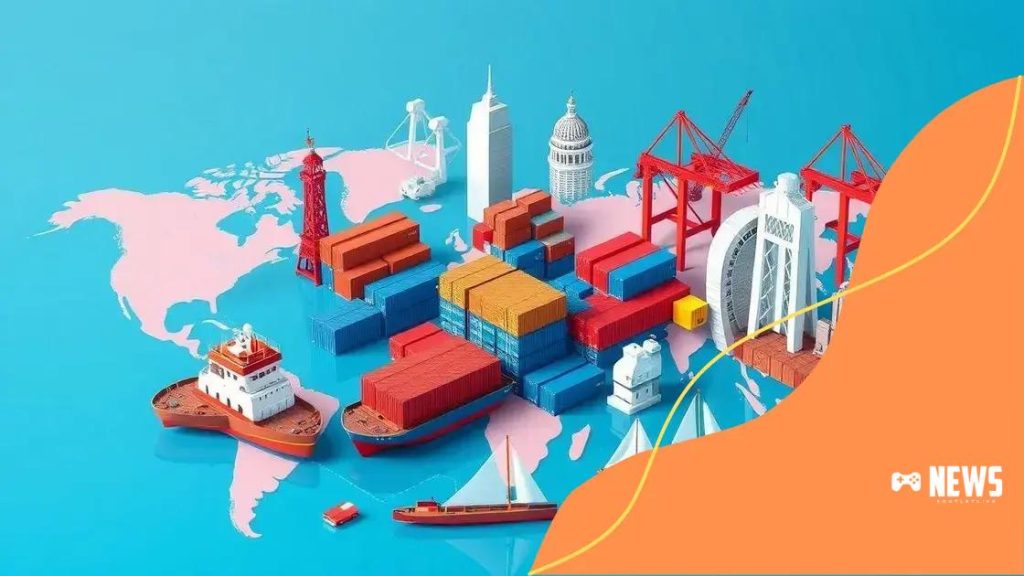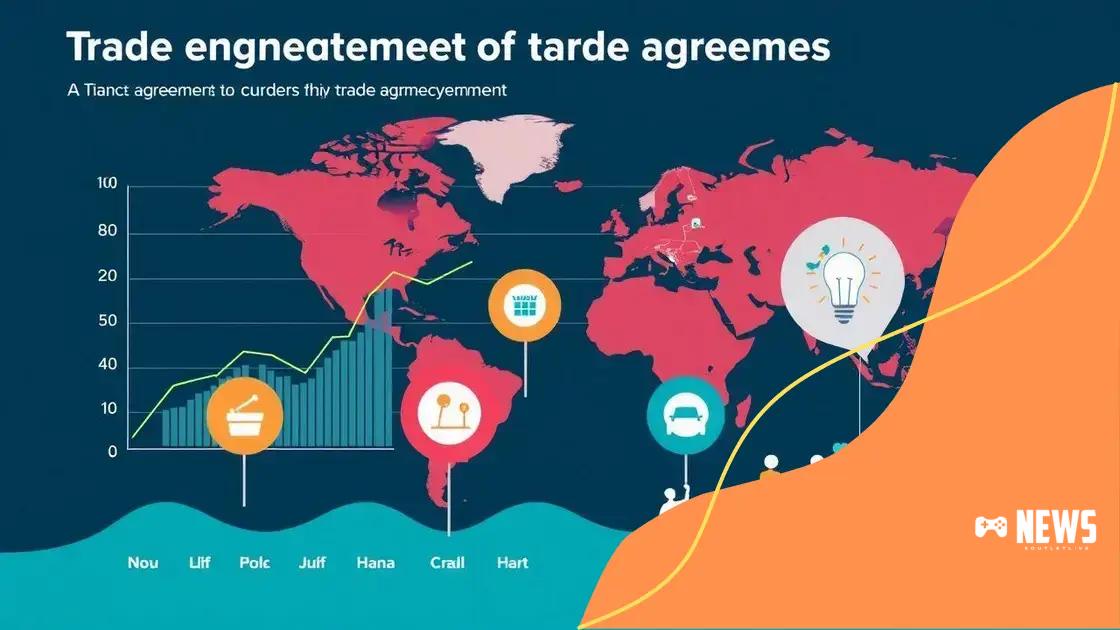International trade relations and negotiations: What you need to know

International trade relations and negotiations are shaped by key factors such as cultural differences, political stability, economic disparities, and the impact of technology, which influence how countries interact and form agreements.
International trade relations and negotiations play a vital role in shaping our global economy. Have you ever wondered how these negotiations impact daily life, from the price of goods to job availability? Let’s delve into this important topic.
Understanding international trade dynamics
Understanding international trade dynamics is essential for grasping how countries interact economically. This area covers various factors that influence trade patterns globally.
Key Concepts in Trade Dynamics
Several elements shape the landscape of international trade. Recognizing these factors can help individuals and businesses navigate the complexities of the market.
- Supply and demand: The availability of goods and services impacts trade volume.
- Trade policies: Tariffs and trade agreements can facilitate or hinder exchanges between nations.
- Currency fluctuations: Changes in currency value can affect the competitiveness of products.
- Political stability: Countries with stable governments often attract more trade.
Another crucial aspect is regional integration. Trade blocs, like the European Union, streamline processes, making it easier for member nations to trade. This integration allows for lower tariffs and shared regulations that benefit all parties involved.
Influences on Trade Relationships
Various factors contribute to the dynamics of international trade. These include historical ties, cultural connections, and economic dependencies. Nations often trade based on these established relationships, ensuring mutual benefits.
Technology also plays a pivotal role. Advances in communication and logistics have enabled faster and more efficient transactions across borders. This shift has led to the rise of e-commerce, allowing businesses of all sizes to participate in global trade.
Global Events and Trade Flows
Natural disasters, economic crises, and pandemics can drastically alter trade patterns. For example, during the COVID-19 pandemic, international trade faced significant disruptions. Supply chains were strained, affecting product availability worldwide.
- Global supply chains: Events can ripple through supply chains, causing delays and shortages.
- Market shifts: Changes in consumer behavior can lead to new trade opportunities.
- Policy changes: Governments may alter trade policies in response to global events.
In conclusion, understanding international trade dynamics requires a comprehensive view of various economic, political, and social factors. By grasping these concepts, individuals and businesses can better prepare for the complexities of the global marketplace. Following these trends helps predict future trade flows.
Key players in trade negotiations
Identifying the key players in trade negotiations is essential for understanding how agreements are formed and implemented. These players significantly influence the outcomes of international trade deals.
Government Representatives
Government officials often serve as the main negotiators. They represent their countries’ interests during discussions. These representatives typically include:
- Trade ministers: Leading negotiations for their nations.
- Ambassadors: Acting as liaisons between countries to facilitate dialogue.
- Economic advisors: Providing insights on the potential impacts of proposed agreements.
The roles of these individuals are crucial as they ensure the negotiations align with their country’s economic goals. They must balance domestic demands with international expectations, which is no small task.
International Organizations
International organizations, such as the World Trade Organization (WTO), also play a vital role in trade negotiations. These bodies help establish guidelines and settle disputes between nations.
Organizations like the WTO ensure that countries adhere to agreed-upon rules. Their involvement lends credibility to negotiations and offers a framework for addressing issues that arise.
Additionally, regional trade organizations, such as the European Union (EU), can affect negotiations by creating specific agreements among member states. This type of collaboration can lead to more powerful economic partnerships.
Private Sector Influencers
The private sector cannot be overlooked. Businesses and trade associations often have a say in negotiations, as their interests can heavily influence government priorities. These groups may include:
- Multinational corporations: They advocate for favorable conditions that enhance their global operations.
- Industry lobbyists: They represent specific industries, urging negotiators to consider particular needs.
- Consumer advocacy groups: They provide feedback on how trade agreements might affect the public.
Their perspective is vital, as successful trade agreements can hinge on the needs of industry and consumers alike. Collaboration between these stakeholders can lead to more effective negotiations that serve the broader economy.
Last but not least, public opinion plays an important role. Citizens and advocacy groups often express concerns about trade deals. As a result, negotiators must consider these perspectives when forming agreements. Understanding the various players involved in trade negotiations provides insight into how these complex discussions take shape.
Impact of trade agreements on economies

The impact of trade agreements on economies is profound and multifaceted. These agreements shape trade flows, influence economic growth, and reflect a nation’s priorities in international relations.
Economic Growth and Expansion
Trade agreements often lead to increased economic growth by opening up new markets. When countries enter into agreements, they reduce tariffs and quotas, allowing businesses to expand their reach.
- Increased exports: Access to new markets boosts sales for domestic producers.
- Job creation: Expanding businesses often hire more workers, which lowers unemployment rates.
- Investment opportunities: Trade agreements can attract foreign investments as companies seek to tap into new markets.
As economies grow, both the public and private sectors benefit. Governments often see increased tax revenues, which can then be invested in public services.
Sectoral Changes and Industry Growth
While trade agreements can spur growth, they can also lead to shifts in specific sectors. Some industries may flourish while others may struggle. For example, a trade agreement that favors agricultural products may benefit farmers but negatively impact local manufacturers unable to compete with cheaper imports.
Industries often respond by adapting to new market conditions. This adaptability can lead to innovation and modernization within sectors that need to adjust to survive.
Trade Deficits and Surpluses
Trade agreements can also influence a country’s trade balance. Depending on the terms, a nation may experience a trade deficit or surplus. A trade surplus occurs when a country exports more than it imports, often viewed as positive for its economy.
If the balance tips in favor of imports, it can lead to a trade deficit, which may raise concerns about economic stability. Maintaining a balanced trade relationship is crucial for long-term economic health, and governments must monitor this closely.
Social and Environmental Considerations
The effects of trade agreements extend beyond economics. They can also influence social conditions and environmental policies in participating nations. For example, some agreements include provisions aimed at improving labor standards and protecting the environment.
Countries must often collaborate to ensure that trade agreements benefit not just their economies but also their populations and the planet. This holistic approach can foster sustainable development, ensuring that progress does not come at the expense of future generations.
Challenges in international negotiations
The challenges in international negotiations are numerous and complex. These obstacles can hinder the progress of discussions and impact the outcomes of trade agreements.
Cultural Differences
Cultural differences often play a significant role in how negotiations unfold. Each country has its own customs and communication styles, which can lead to misunderstandings and conflicts.
- Language barriers: Miscommunication can occur when negotiators speak different languages or use jargon.
- Negotiation styles: Some cultures may prioritize directness, while others may value indirect approaches, affecting how proposals are presented and discussed.
- Different priorities: Countries may focus on varying issues depending on their economic needs and political situations, complicating consensus.
Understanding these cultural nuances is crucial for effective negotiation. By being aware of these differences, parties can develop strategies to bridge the gaps and foster cooperation.
Political Instability
Another challenge is the impact of political instability. Governments may change, leading to shifts in policy priorities that affect negotiations. A new administration might not honor previous agreements or may demand renegotiation of key terms.
This unpredictability can discourage foreign investment and make it difficult for businesses to plan long-term strategies. Unstable political environments can also create concerns about compliance with trade agreements, leading to hesitance from other nations to engage.
Economic Disparities
Economic disparities between negotiating countries also pose significant obstacles. Wealthier nations often have different resources and priorities compared to developing countries, making it challenging to find common ground.
Discussions around tariffs, subsidies, and market access can become contentious. Wealthier nations might push for terms favorable to them, which can leave poorer countries feeling marginalized.
Negotiation Deadlocks
Deadlocks can occur when parties cannot reach an agreement, leading to stalled negotiations. These situations can arise due to inflexible positions or conflicting demands. When negotiators are unwilling to compromise, progress halts, creating frustration on all sides.
- Stubbornness: Adhering too rigidly to one’s own agenda can prevent successful outcomes.
- Lack of trust: Previous conflicts or failures can lead to skepticism, making parties hesitant to make concessions.
- Unrealistic expectations: Entering negotiations with expectations that are too high can set the stage for disappointment.
In navigating these challenges, effective communication and strategic planning are essential. Building relationships among negotiators can enhance understanding and lead to smoother discussions, even in the face of these obstacles.
Future trends in trade relations
Examining the future trends in trade relations reveals a landscape that is continually evolving. As economies adapt to new challenges and technologies, international trade will experience significant shifts.
Technological Advancements
One of the most critical factors shaping future trade relations is technology. Innovations such as artificial intelligence and blockchain are revolutionizing the way goods and services are exchanged. These technologies can streamline processes, enhance security, and reduce costs.
- Automation: Increased automation in manufacturing may lead to faster production times.
- E-commerce growth: Online trading platforms are expanding access to global markets for small businesses.
- Data-driven decisions: Companies are using data analytics to tailor their offerings and optimize supply chains.
As technology continues to advance, companies that adapt will likely flourish in the competitive global marketplace.
Sustainability and Environmental Concerns
Sustainability is becoming a central focus in trade relations. As awareness of environmental issues grows, nations will likely prioritize eco-friendly practices in trade agreements.
For example, countries may establish regulations requiring sustainable sourcing and production methods. This trend could lead to collaborations aimed at reducing carbon footprints and promoting renewable resources.
Shifts in Global Power Dynamics
The balance of power among countries is also changing. Emerging economies, particularly in Asia and Africa, are gaining influence in global trade discussions. These nations bring new perspectives and priorities to negotiations, which can reshape existing agreements.
As they grow economically, their demands for fair trade practices will increase. This shift may create more equitable trade relationships, where developing countries have a stronger voice.
Political and Economic Factors
Political changes can significantly impact trade relations. Events such as trade wars, shifts in government, and global crises can alter how countries interact economically.
- Trade policies: Countries may adopt protectionist measures to shield local industries.
- International collaborations: Alliances could form between nations to counterbalance economic pressures.
- Regional agreements: More localized agreements may become common as countries seek to navigate complex global dynamics.
Understanding these factors will be crucial for businesses looking to succeed in the global market. Keeping an eye on these trends will prepare companies to adapt their strategies accordingly as trade relations evolve.
In summary, the landscape of international trade is complex and ever-changing. The key players, technological advancements, and the impact of policies shape trade relations. Understanding these dynamics helps businesses navigate challenges and seize opportunities. As we look toward the future, it’s essential to stay informed about evolving trends and adapt strategies accordingly. By doing so, companies can thrive in the global market and contribute to a more connected world.
FAQ – Frequently Asked Questions about International Trade Relations
What are the key factors influencing international trade negotiations?
Key factors include cultural differences, political stability, technological advancements, and economic disparities among negotiating countries.
How do trade agreements impact local economies?
Trade agreements can boost local economies by increasing exports, creating jobs, and attracting foreign investment while potentially causing sector shifts.
What role does technology play in future trade relations?
Technology enhances efficiency in trade, aids in data analysis, and facilitates new trading platforms, thus transforming how countries interact.
Why is sustainability important in trade relations?
Sustainability ensures that trade practices do not harm the environment and promote social responsibility, making agreements more attractive to modern consumers and businesses.





